

FOAF Vocabulary Specification. Classes Class: foaf:Agent Agent - An agent (eg. person, group, software or physical artifact).
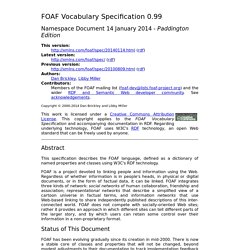
The Agent class is the class of agents; things that do stuff. A well known sub-class is Person, representing people. Other kinds of agents include Organization and Group. The Agent class is useful in a few places in FOAF where Person would have been overly specific. [#] [back to top] Class: foaf:Document Document - A document. The Document class represents those things which are, broadly conceived, 'documents'. The Image class is a sub-class of Document, since all images are documents. We do not (currently) distinguish precisely between physical and electronic documents, or between copies of a work and the abstraction those copies embody. [#] [back to top] Class: foaf:Group Group - A class of Agents. The Group class represents a collection of individual agents (and may itself play the role of a Agent, ie. something that can perform actions).
Here is an example. <! [#] [back to top] UMBEL Web Services (hosted by Structured Dynamics) UMBEL Web services are supported by the structWSF Web services framework.
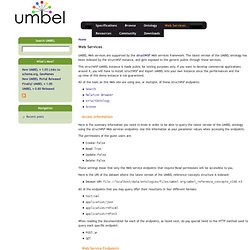
The latest version of the UMBEL ontology has been indexed by the structWSF instance, and gets exposed to the generic public through these services. This structWSF-UMBEL instance is made public for testing purposes only. If you want to develop commercial applications around it, you will have to install structWSF and import UMBEL into your own instance since the performances and the up-time of this demo instance is not guaranteed. All of the tools on this Web site are using one, or multiple, of these structWSF endpoints: Access Information Here is the summary information you need to know in order to be able to query the latest version of the UMBEL ontology using the structWSF Web services endpoints.
Taxonomy Warehouse - information organization, metadata, knowledge management, classification tools. Protege Ontologies Library. SWEET Ontologies. TOVE Ontology Project. Ontology development. SKOS Simple Knowledge Organization System - home page. SKOS is an area of work developing specifications and standards to support the use of knowledge organization systems (KOS) such as thesauri, classification schemes, subject heading lists and taxonomies within the framework of the Semantic Web ...
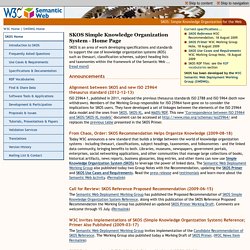
[read more] Alignment between SKOS and new ISO 25964 thesaurus standard (2012-12-13) ISO 25964-1, published in 2011, replaced the previous thesaurus standards ISO 2788 and ISO 5964 (both now withdrawn). Members of the Working Group responsible for ISO 25964 have gone on to consider the implications for SKOS users. They have developed a set of linkages between the elements of the ISO 25964 data model and the ones from SKOS, SKOS-XL, and MADS/RDF. From Chaos, Order: SKOS Recommendation Helps Organize Knowledge (2009-08-18) Call for Review: SKOS Reference Proposed Recommendation (2009-06-15) The Semantic Web Deployment Working Group has published the Proposed Recommendation of SKOS Simple Knowledge Organization System Reference.
Welcome to the Bibliographic Ontology Website. OBO Relation Ontology. An ontology of core relations for use by OBO Foundry ontologies OBO_REL is deprecated.
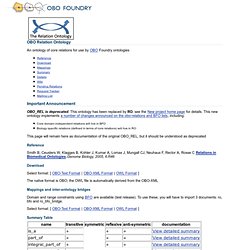
This ontology has been replaced by RO, see the New project home page for details. This new ontology implements a number of changes announced on the obo-relations and BFO lists, including: Core domain-independent relations will live in BFO Biology specific relations (defined in terms of core relations) will live in RO This page will remain here as documentation of the original OBO_REL, but it should be understood as deprecated Reference Smith B, Ceusters W, Klagges B, Kohler J, Kumar A, Lomax J, Mungall CJ, Neuhaus F, Rector A, Rosse C Relations in Biomedical Ontologies.Genome Biology, 2005, 6:R46 Download Select format: [ OBO-Text Format | OBO-XML Format | OWL Format ] OBO-Edit - Overview. BioTop - A Top-Domain Ontology for the Life Sciences. Overview The flood of data and factual knowledge in biology and medicine requires principled approaches to their proper analysis and management.
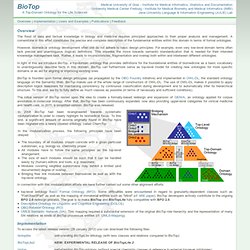
A cornerstone in this effort constitutes the precise and complete description of the fundamental entities within this domain in terms of formal ontologies. However, biomedical ontology development often still do not adhere to basic design principles: For example, even very low-level domain terms often lack precise and unambiguous (logical) definitions. This impedes the move towards semantic standardization that is needed for their intended knowledge management task.
Rather, it leads to inconsistencies, fragmentation and overlap both within and inbetween different ontologies. In light of this we introduce BioTop, a top-domain ontology that provides definitions for the foundational entities of biomedicine as a basic vocabulary to unambiguously describe facts in this domain. Implementation Users and Examples Publications Feedback.
DAML Ontologies. Ontology. The Product Types Ontology: Use Wikipedia pages for describing products or services with GoodRelations. The Suggested Upper Merged Ontology (SUMO) - Ontology Portal.